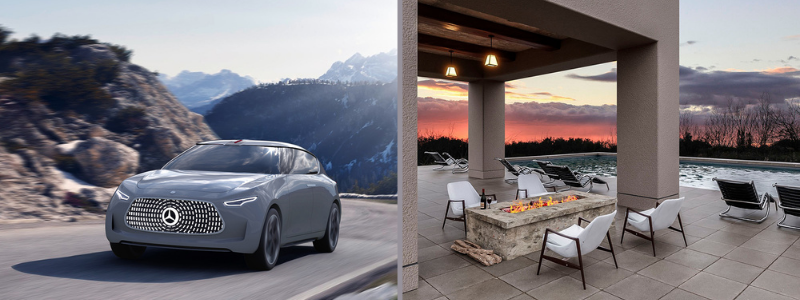What began as a developmental platform for the entertainment industry, Virtual Reality (VR) has also boasted serious business aptitudes—initially designed to allow users to immerse themselves in the fantasy world of games and movies. Anyone can implement the same concept in their business to enrich their buyers’ shopping experiences, product test-runs, and enjoy the process of marketing their content.
We all agree that VR generates a space differently from reality. In contrast, similar technology, Augmented Reality (AR), intensifies users’ digital experience by adding interactive elements to inanimate objects. Some experts agree that both technologies will continue to converge over time. In the business environment, a prime utilization of VR is marketing. The interactive nature of VR apps, videos, and other content establishes a solid emotional connection between a buyer, product, and company.
Soon, more brands will begin to explore and harness virtual reality to improve customer experience to increase loyalty. The aim is to make a personalized digital experience from which customers develop an association with products and services. Correctly produced, VR can take many small businesses of every industry to a succeeding marketing and sales efficiency level.
 Table of Contents
Table of Contents
How VR helps small businesses
The first step is to figure out a type of interactive content in VR that can improve a business and grow revenue. Here are some examples:
The “try before you buy” concept
VR is a revolutionary approach to the time-tested “try before you buy” concept in the retailer business. A VR app for a specialty shop that sells home appliances, furniture, clothing products, or sporting goods enables buyers to glance at every product and try it in a digital setting. They can examine how the new soccer ball glides on the floor or whether a coffee table is large enough for several drinks and a laptop.
An advanced VR app may offer an option for buyers to see how clothes look on avatars that match their actual measurements. How about offering a test run on that coffee table where buyers can digitally design an entire room with a whole set of furniture pieces available from the store? Providing an exploded view of a power toolset with the description of how each component works will impress you and the buyers, too.
A VR headset takes your buyer to an interactive virtual environment where they can move from aisle to aisle in an instant. The VR controller acts as a hand in the digital space to grab and move items into a shopping cart. The VR app can replace a web interface where buyers use mouse keys and a keyboard to select and purchase products from a general store.
VR-based courses
In the vocational training sector, VR utilization can help a great deal. The digital world can simulate a real-life environment and tools and equipment to create virtual art or craft courses. The immersive interaction possibility of VR helps learners explore different situations to gain experimental knowledge at their own pace. Driving instructors can also use VR technology to put learners into various road conditions and traffic density levels. When in reality, the situations are considered too dangerous for new drivers, VR acts as a secure medium without sacrificing the value of the lessons.
RELATED: Selling homes remotely using VR architectural services to create virtual tours

Virtual tourism
One of the most famous utilization of VR is in the tourism industry. When your business provides an adventurous experience for families, VR technology can convey a glimpse of some attractions. VR simulation can bring clients into a digital world filled with amusement parks, wildlife, oceans, campgrounds, and mountains. The virtual environment can package a digital representation of any resort, too. Take your customers on an adventure before arriving at the locations.
Budget concern
Like just about every software development, the cost of building a VR app depends on the complexity level of the interface itself. The developer’s reputation, location, and platforms are among other things to consider while budgeting. Here is a simple rundown of what you can expect to pay based on the type of VR app you want:
- A simple game: $5,000 to $8,000
- Online store with VR effect: $15,000 to $25,000
- Advanced game: $20000 to $80000
- MMORPG: $50000 to $100000
The actual cost will mostly depend on your personal preferences. Professional developers can always cater to every client’s needs, and as a rule of thumb, adding more features require more time and money. When your budget is somewhat limiting, there are some ways to help reduce the cost:
DIY method
Some VR companies choose to offer do-it-yourself services through web interfaces. They supply you with platforms or design tools to add interactive elements to the otherwise inanimate objects, products, or printed materials. The design tools are built with easy-to-use methods, allowing non-developers to create their own VR app without much of a hassle. This type of service typically requires a monthly subscription cost.
Software development kit (SDK)
The best thing about SDKs is that they can build apps without writing the codes from scratch. Plenty of them, including from well-known platforms such as Oculus, Samsung VR, PlayStation, and Google, used this method. You will still require developers when using an SDK, but you can launch the app quicker and save money in the process. Always compare options because SDKs can vary significantly in terms of speed and features.
Work with freelancers
Browse through VR developers that offer the type of service you need at competitive rates on a freelancing website. Reading their testimonies and performance levels will help you understand their experience in complex conditions. Their specializations vary from browser development, VR games, e-commerce, and more. It is recommended to start your developer with a small task to see if the work is of good quality before moving onto a larger project.
If you are not a developer, the best thing you can do is learn VR basics before hiring. Understanding how it works will help you manage the expectation. Ask any relevant questions as you can to the freelancers or agencies you consider for your project.
A step ahead of traditional sales strategy
Large companies with established brands can provide prime examples of how VR technology helps reshape their marketing strategies. Audi has been using proprietary software developed by ZeroLight to allow buyers to configure their personalized cars in real-time. Other carmakers such as Toyota, BMW, and Lamborghini are doing more or less of the same. Of course, the automotive giants hold massive financial resources – something most small businesses don’t.
One of the benefits of virtual reality is clients can do little to no damage to products to prevent significant financial loss. Another way is to have printed marketing materials such as flyers or brochures presented as digital information. Viewers are more likely to be captivated by diagrams, images, and colorful graphics.
RELATED: Virtual reality in CAD design – Looking forward

Powerful online video marketing content
Regardless of the industry, most of today’s small businesses rely on the internet for their marketing—platforms like blogs, social media, forums, and so on. Additionally referred to as “content marketing,” business owners publish narratives of their companies and products in the hope of attracting more customers. Small businesses have an affordable, familiar channel to tell their tales and build a customer base on platforms such as Twitter and Instagram. Having greater social media exposure implies an increase in online presence, which ultimately affects conversion rates.
Considering that 360-degree VR video is still a novelty, it will give a business an edge over competitors. A virtual tour of your physical store, interactive animated product descriptions, and a detailed view of the product itself provides better chances of improving search engine performance and increase audience engagement. You want to achieve good organic reach in online marketing, meaning the content is so effective that you generate plenty of leads without paying any advertising fee to search engines or websites.
The only investment you make is making the content in the first place. There is no guarantee that your VR video will be found attractive enough, but hiring a reputable 3D Virtual Reality Services to create the content can make the campaign much more efficient. You are not making an app here; it is a video project that a professional should do within a week. Price is more affordable, yet anybody, even with a cheap VR goggle, can enjoy it.
A brighter future
VR is no longer in its infancy, especially in the gaming and entertainment industry, though things are pretty different in the small business sector. Big brands with big budgets remain the dominating force in VR iterations, whereas small businesses have to stay behind due to development costs. As soon as the technology becomes more affordable, which is perpetually the case, small businesses and their customers will most likely become significant participants instead of spectators.
How Cad Crowd can help
At Cad Crowd, we have the privilege of working with hundreds of the best VR design services in the world. If you’re looking for help with a project, find out how it works today or get a free quote.

